CES 2006: Motherboards, Memory, Cooling, and a Few Surprises
by Wesley Fink & Jarred Walton on January 11, 2006 12:05 AM EST- Posted in
- Trade Shows
ECS
ECS has had a few interesting designs lately. First is their hybrid motherboard platform, the PF88 Extreme Hybrid, which allows you to convert to most other CPU/RAM platforms with the purchase of the appropriate daughtercard.
Presently supported are socket 754, 939, and 479. This product has apparently done quite well in Europe and Asia, but honestly, it doesn't impress us too much. By the time you spend $40 for the daughtercard and buy a new CPU and RAM, you've spent nearly as much as what you would pay for a new platform. We would prefer to keep the old system as a secondary unit or sell it off rather than worry about plugging in a new CPU, RAM, and daughtercard and leaving the existing components in place. Some of you might still find it worthy of consideration; we would say it's interesting, but we simply don't find it particularly useful.
Multi-GPU motherboards were a major theme at ECS, with some choices that we will have to test before recommending. Every possible official option is present or in development, along with a couple of unofficial configurations. ECS was one of the few places with an RD400X based system in development, and they actually have two: The PA1 MVP and the PA1 MVP Lite. The major difference is that the Lite model omits Gigabit Ethernet support and Firewire. Both are CrossFire platforms for Intel systems.
Even more unusual are the next two multi-GPU boards, both also for socket 775. The first is the PF22, a 955X-based motherboard with two X16 slots, one with only a 4X data connection, which is nevertheless listed as being CrossFire ready. The PF5 goes one step further, sporting a 945P chipset with the same X16 slot configuration, only with the claim that it is SLI hardware ready. Both are Extreme series boards, though whether they're truly geared towards the enthusiast or not remains to be seen. ECS does have a 975X board in development as well, with dual X16 slots (both with X8 data connections). Like Aopen, their 975X board will support the Core Duo ( Yonah) chips and socket 479 as opposed to 775. All three of these boards are unusual in some form or another, and we're curious to see how they actually work in practice.
What we would really like to see is for ATI and NVIDIA to both quit arguing about chipset superiority and simply allow their cards to run on any available platform. We've seen SLI on 975X and Xpress 200, and we've seen CrossFire on all the dual-X16 slot boards. While selling both the graphics cards and the motherboard chipset brings in more money, it's better to at least sell the graphics cards than to not sell anything at all.
In the more typical areas, ECS has a dual X16 SLI board in development for socket 939, the KN2 SLI. A standard dual X8 SLI board is also available, the KN1 SLI Lite. CrossFire isn't being neglected either for AMD systems, as both the RD480 and RD580 chipsets will be supported. However, the RD580 solution will be for socket M2 (now AM2) rather than socket 939, so it's still about six months out.
There are also plenty of boards that don't include support for multiple GPUs in the works or already shipping, but these weren't as attention-grabbing as the above options. Then again, there's something to be said for sticking with the guidelines of Intel, ATI, NVIDIA, and AMD. Going against the grain is a good way to stand out, but we can only hope that it will be standing out in a good way rather than serving as an example of what not to do. Time will tell whether ECS is being creative or merely insane.
ECS also had a Viiv ready solution on display, the P60. The unit is sleek and relatively attractive, and it includes a Mini-PCI TV tuner. It remains to be seen whether ECS will be selling the P60 directly or sourcing it for other interested parties. How many of these Viiv systems will reach market and how they'll perform is still up in the air, but clearly, Intel's current direction is to push that market. Hopefully, we'll get some units in-house for further testing in the not-too-distant future.
ECS has had a few interesting designs lately. First is their hybrid motherboard platform, the PF88 Extreme Hybrid, which allows you to convert to most other CPU/RAM platforms with the purchase of the appropriate daughtercard.

Presently supported are socket 754, 939, and 479. This product has apparently done quite well in Europe and Asia, but honestly, it doesn't impress us too much. By the time you spend $40 for the daughtercard and buy a new CPU and RAM, you've spent nearly as much as what you would pay for a new platform. We would prefer to keep the old system as a secondary unit or sell it off rather than worry about plugging in a new CPU, RAM, and daughtercard and leaving the existing components in place. Some of you might still find it worthy of consideration; we would say it's interesting, but we simply don't find it particularly useful.

Multi-GPU motherboards were a major theme at ECS, with some choices that we will have to test before recommending. Every possible official option is present or in development, along with a couple of unofficial configurations. ECS was one of the few places with an RD400X based system in development, and they actually have two: The PA1 MVP and the PA1 MVP Lite. The major difference is that the Lite model omits Gigabit Ethernet support and Firewire. Both are CrossFire platforms for Intel systems.
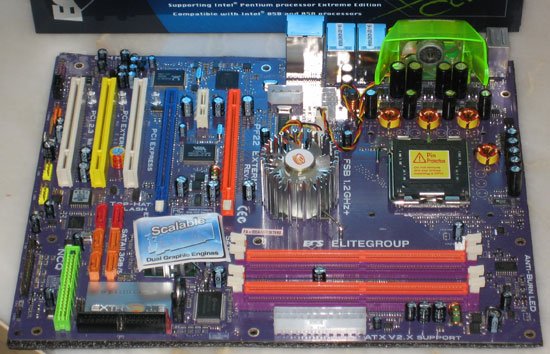
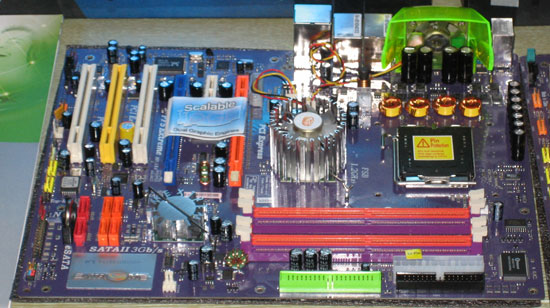
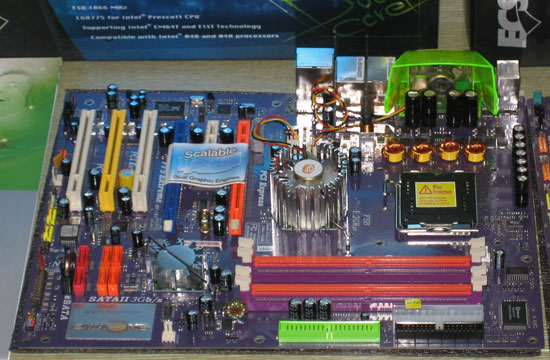
Even more unusual are the next two multi-GPU boards, both also for socket 775. The first is the PF22, a 955X-based motherboard with two X16 slots, one with only a 4X data connection, which is nevertheless listed as being CrossFire ready. The PF5 goes one step further, sporting a 945P chipset with the same X16 slot configuration, only with the claim that it is SLI hardware ready. Both are Extreme series boards, though whether they're truly geared towards the enthusiast or not remains to be seen. ECS does have a 975X board in development as well, with dual X16 slots (both with X8 data connections). Like Aopen, their 975X board will support the Core Duo ( Yonah) chips and socket 479 as opposed to 775. All three of these boards are unusual in some form or another, and we're curious to see how they actually work in practice.
What we would really like to see is for ATI and NVIDIA to both quit arguing about chipset superiority and simply allow their cards to run on any available platform. We've seen SLI on 975X and Xpress 200, and we've seen CrossFire on all the dual-X16 slot boards. While selling both the graphics cards and the motherboard chipset brings in more money, it's better to at least sell the graphics cards than to not sell anything at all.
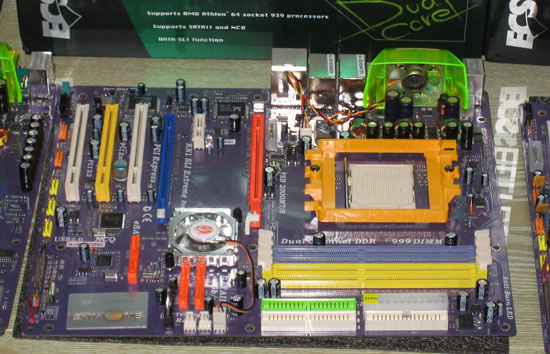
In the more typical areas, ECS has a dual X16 SLI board in development for socket 939, the KN2 SLI. A standard dual X8 SLI board is also available, the KN1 SLI Lite. CrossFire isn't being neglected either for AMD systems, as both the RD480 and RD580 chipsets will be supported. However, the RD580 solution will be for socket M2 (now AM2) rather than socket 939, so it's still about six months out.
There are also plenty of boards that don't include support for multiple GPUs in the works or already shipping, but these weren't as attention-grabbing as the above options. Then again, there's something to be said for sticking with the guidelines of Intel, ATI, NVIDIA, and AMD. Going against the grain is a good way to stand out, but we can only hope that it will be standing out in a good way rather than serving as an example of what not to do. Time will tell whether ECS is being creative or merely insane.
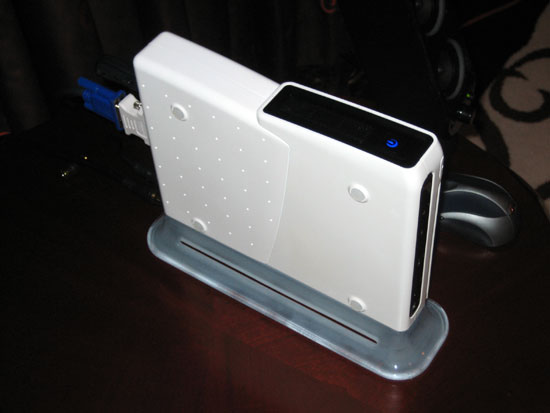
ECS also had a Viiv ready solution on display, the P60. The unit is sleek and relatively attractive, and it includes a Mini-PCI TV tuner. It remains to be seen whether ECS will be selling the P60 directly or sourcing it for other interested parties. How many of these Viiv systems will reach market and how they'll perform is still up in the air, but clearly, Intel's current direction is to push that market. Hopefully, we'll get some units in-house for further testing in the not-too-distant future.










36 Comments
View All Comments
semo - Wednesday, January 11, 2006 - link
am i the only one annoyed of the fact that the graphics card is almost always ignored when it comes to exotic cooling.why no phase change cooling option for you graphics card? and not just the gpu i'm talking about the memory aswell. pc ram may not get very hot but gddr does.
Puddleglum - Wednesday, January 11, 2006 - link
Check this image: http://images.anandtech.com/reviews/tradeshows/200...">http://images.anandtech.com/reviews/tra...ows/2006...Turin39789 - Wednesday, January 11, 2006 - link
Now that just needs to drop to $299 and we'll be all setTurin39789 - Wednesday, January 11, 2006 - link
This was the problem I saw with the ocz phase change setup. It seemed very nice for extreme cpu speeds, but it would be nice if they offered an expanded system that had cooling for other system componentsJynx980 - Wednesday, January 11, 2006 - link
Can you imagine being the one responsible for getting that $50,000 Brightside TV to the show and then f-cking it up?!"Oooooh, sorry guys, my bad."
JustAnAverageGuy - Wednesday, January 11, 2006 - link
OUCH! That's gotta suck.
JarredWalton - Wednesday, January 11, 2006 - link
Supposedly was the shipping company. That's a hefty insurance bill, I'd wager. It was pretty awesome to see true black from such a crisp LCD, though. They had Doom 3 shots and some other stuff running, and it was all very impressive looking. Hopefully, we can see something get into the market like this in the next year!DigitalDivine - Wednesday, January 11, 2006 - link
i like the tiny dualcor computer. if it has a vga out and usb in, this will be a winner and i would get one as fast as i can.Wesley Fink - Wednesday, January 11, 2006 - link
According to the Specifications, the DualCor has 3 USB 2.0 ports (2 type A and 1 type B), a mini VGA port, and a compact Flash slot. It also has both 1GB of DDR2 Memory and 1GB of Flash Memory. It looks like your wishes are all there.JarredWalton - Wednesday, January 11, 2006 - link
They had it hooked to an LCD, but I don't know if it can run non-native resolutions or not. (Probably a driver update will be required, as at the show it was only outputting 800x480.) It looks like the unit is in early Beta to me, but it's still pretty interesting. Getting 40GB of easily accessible storage for your PDA is nice.